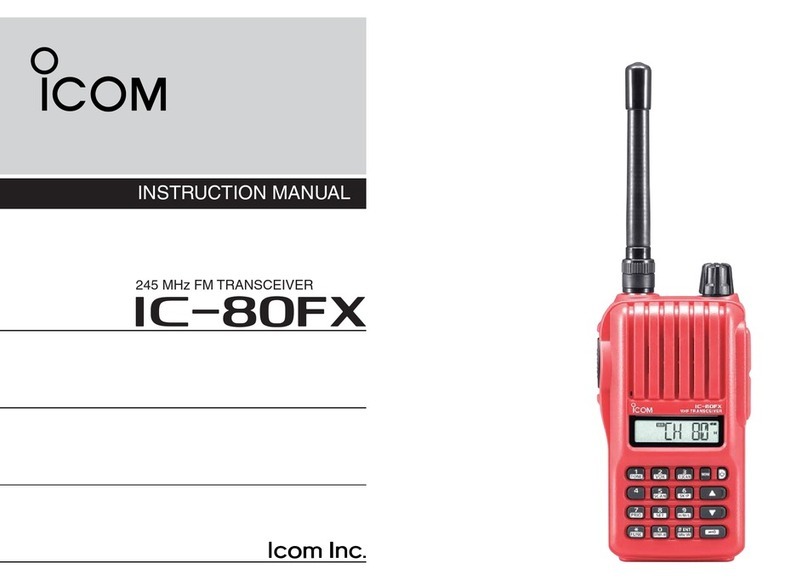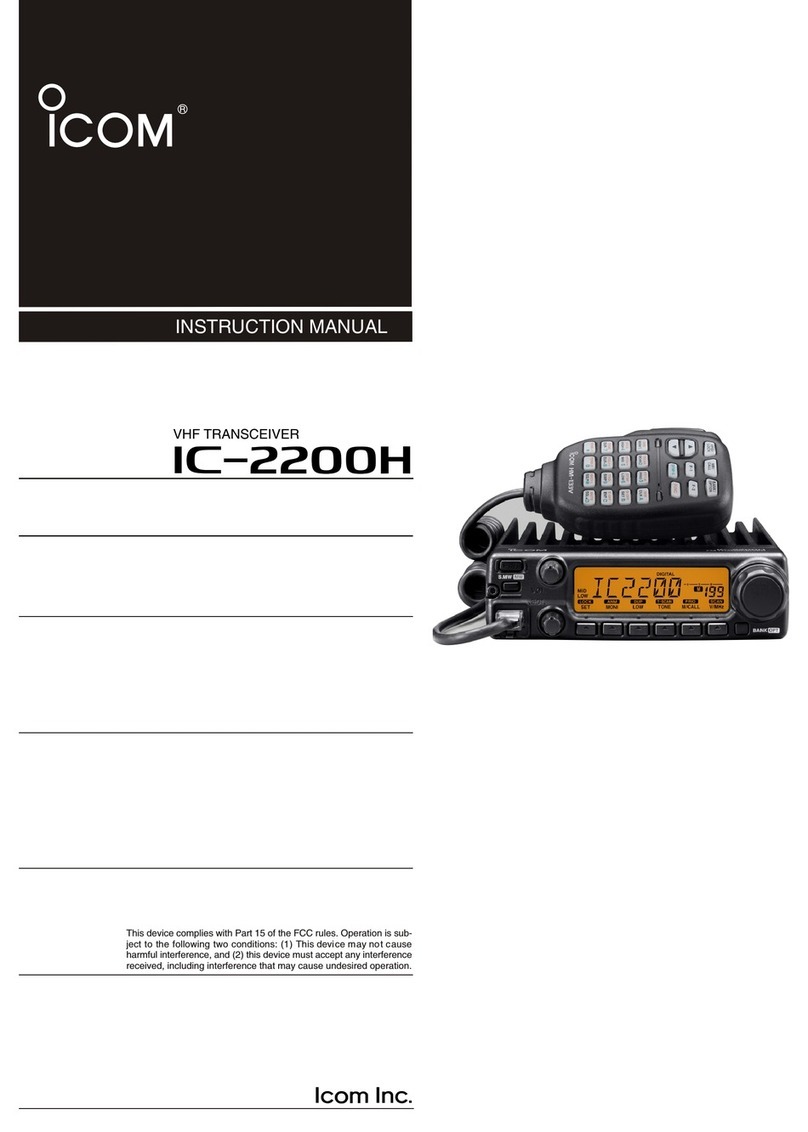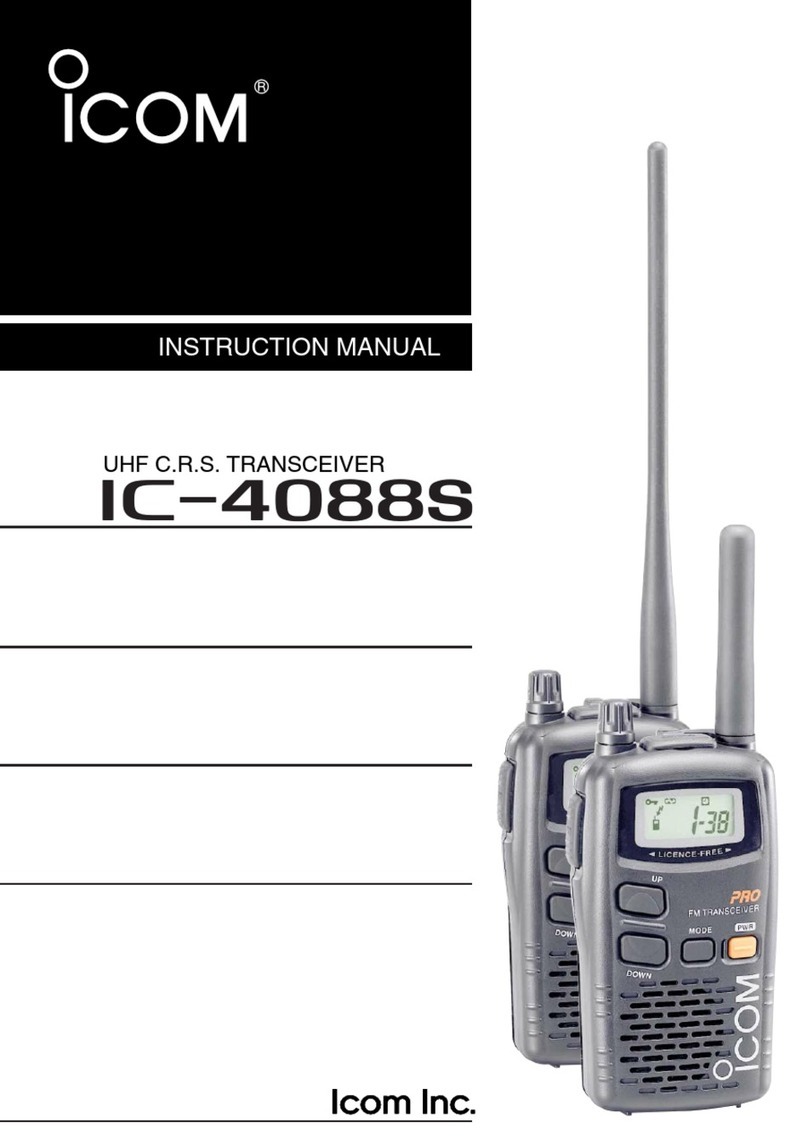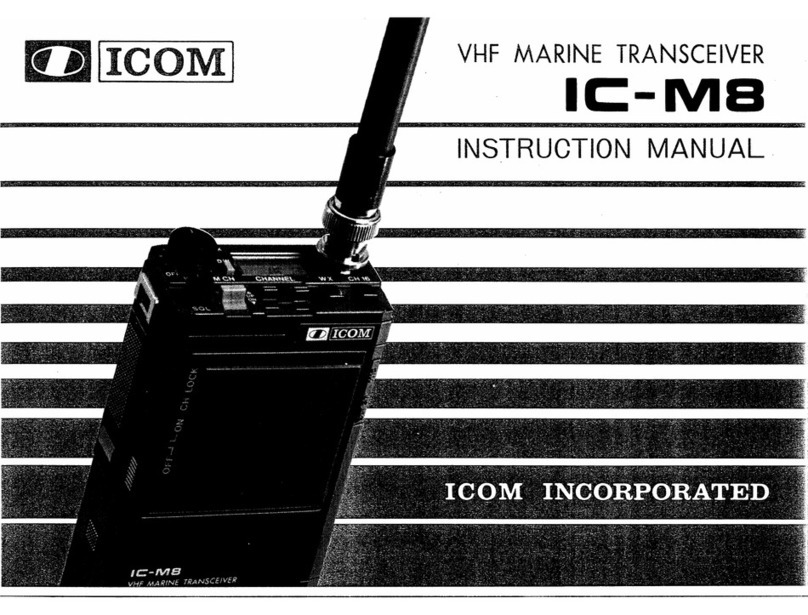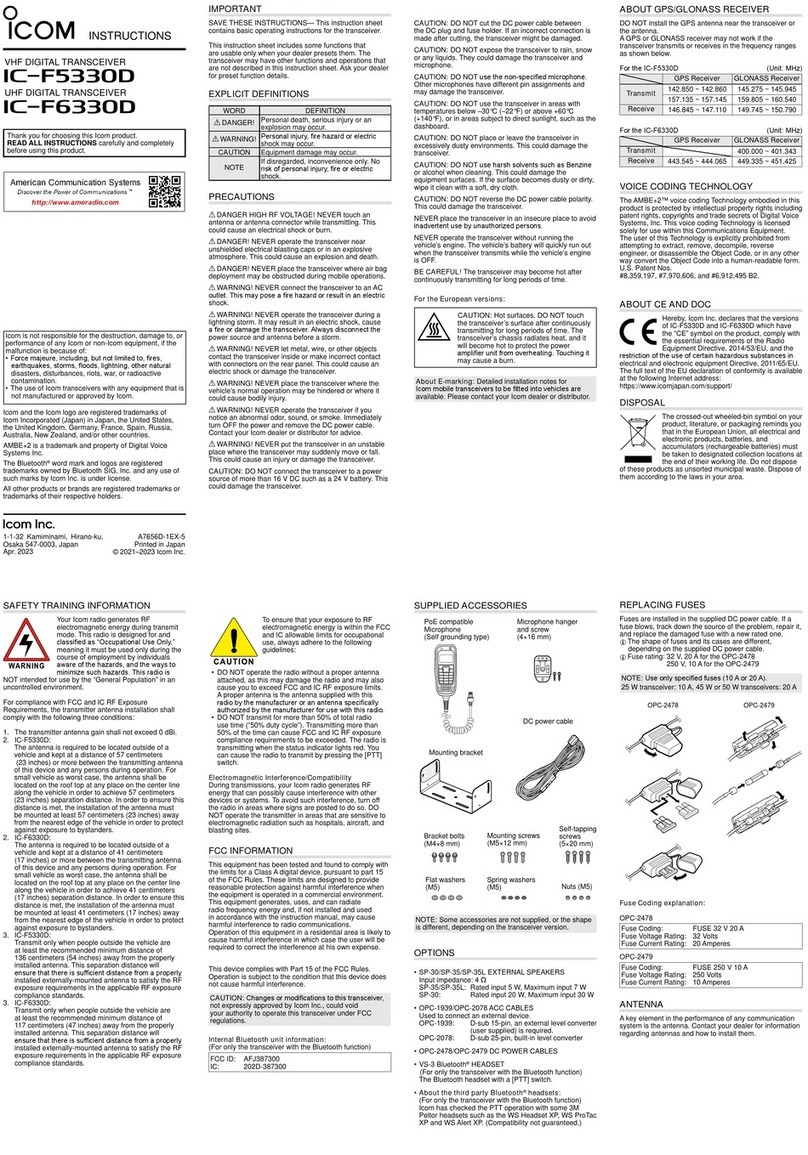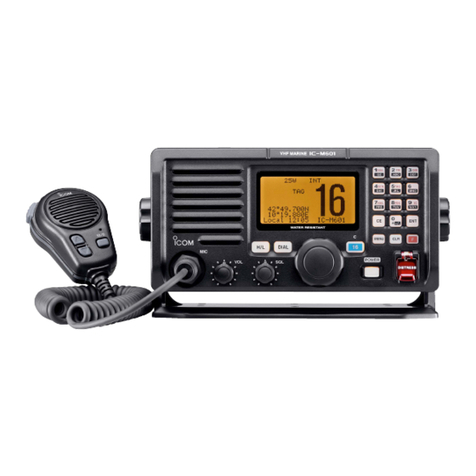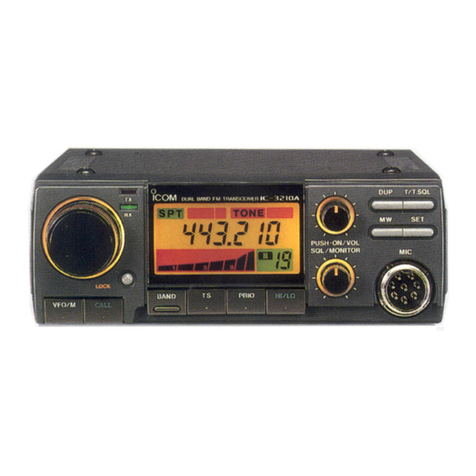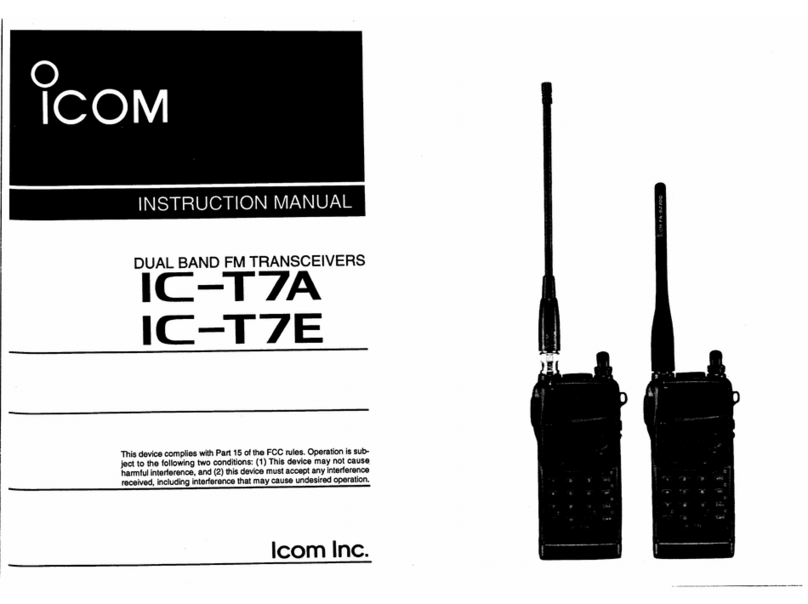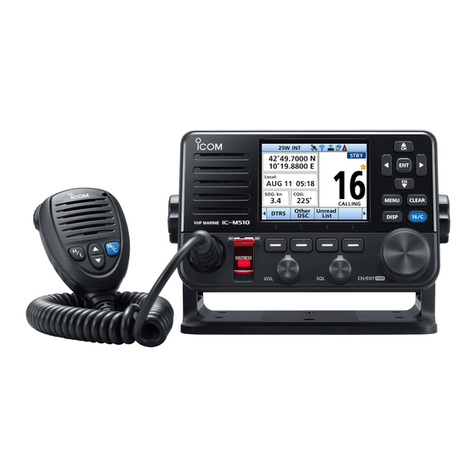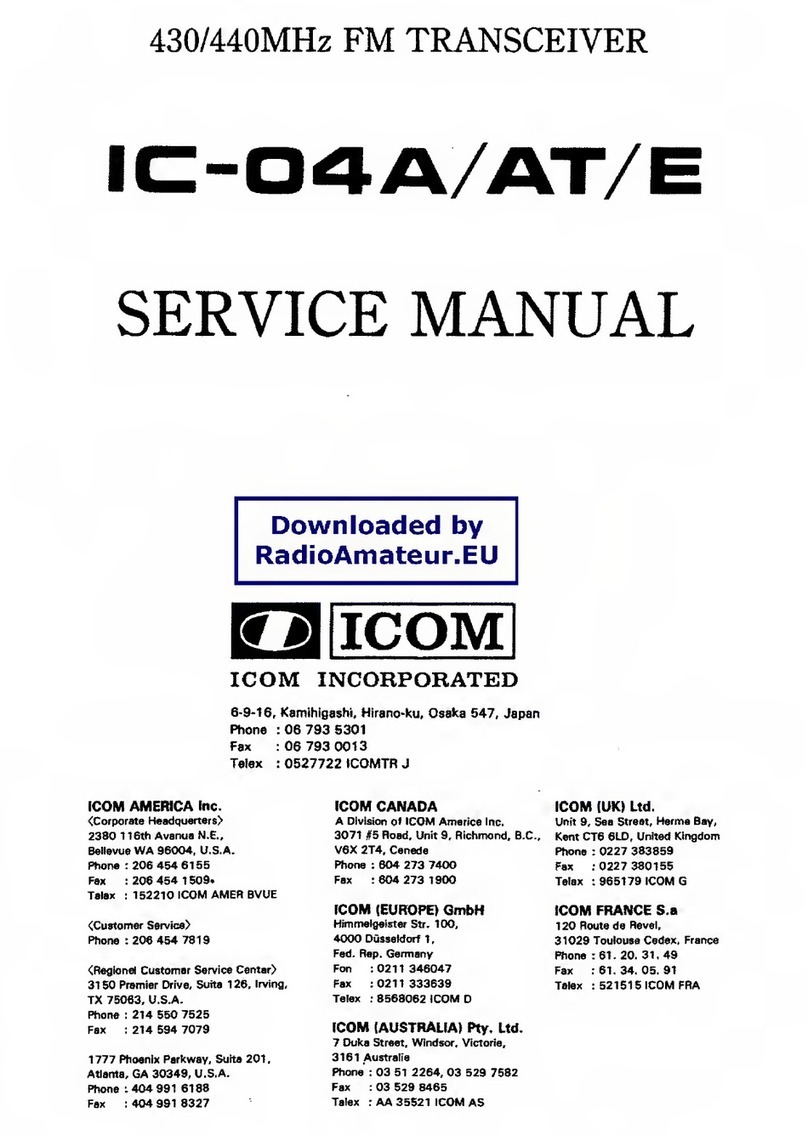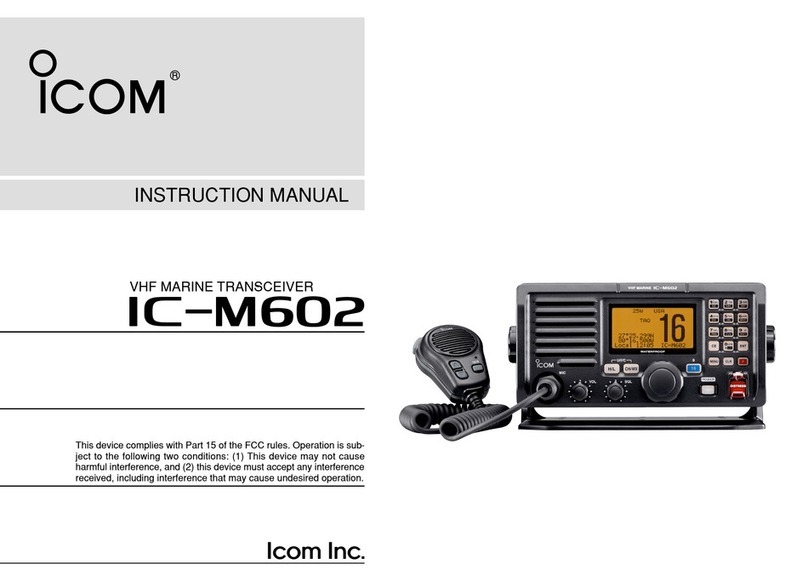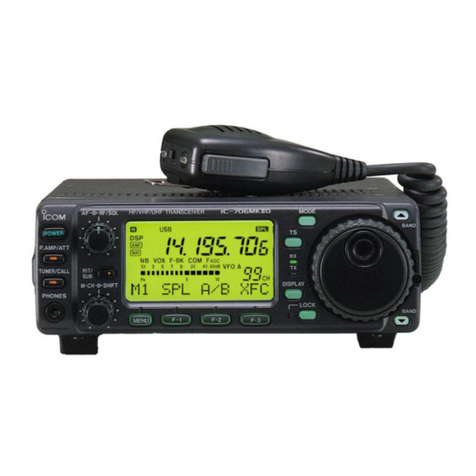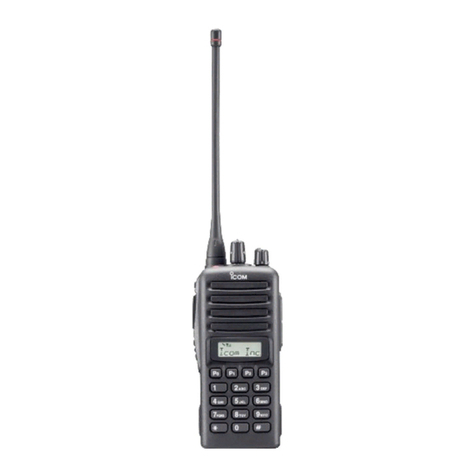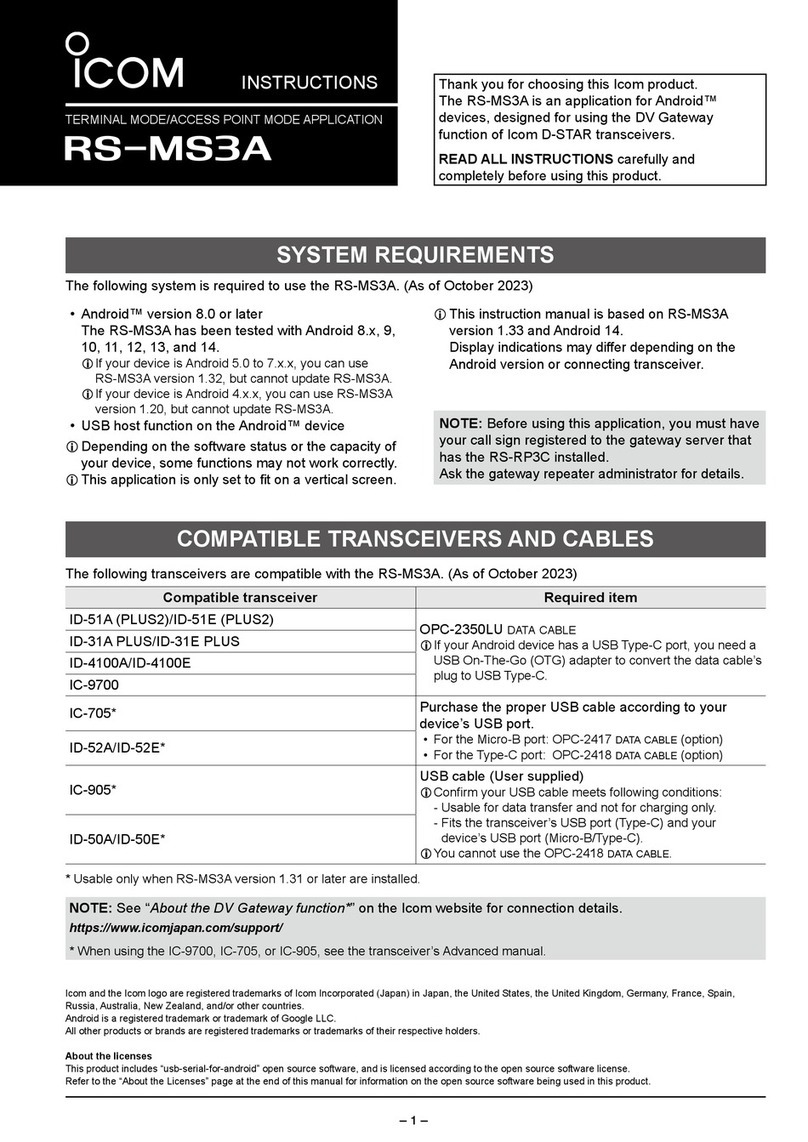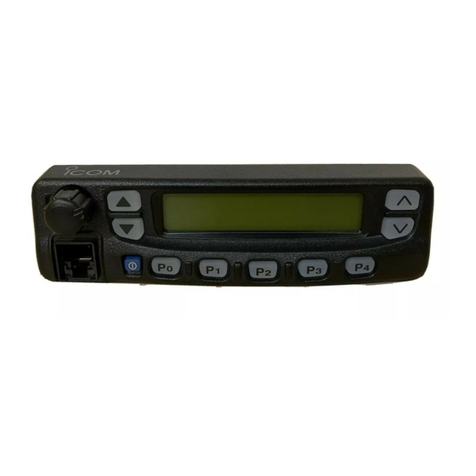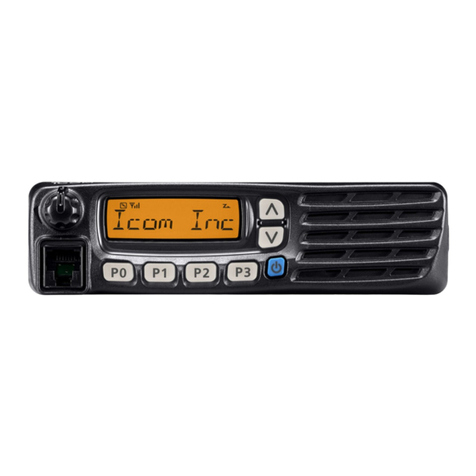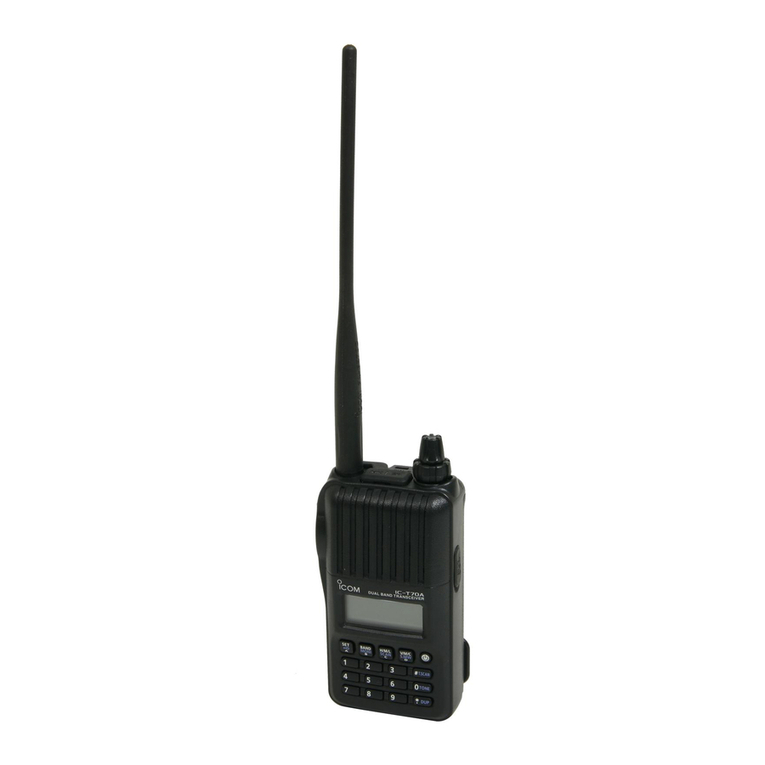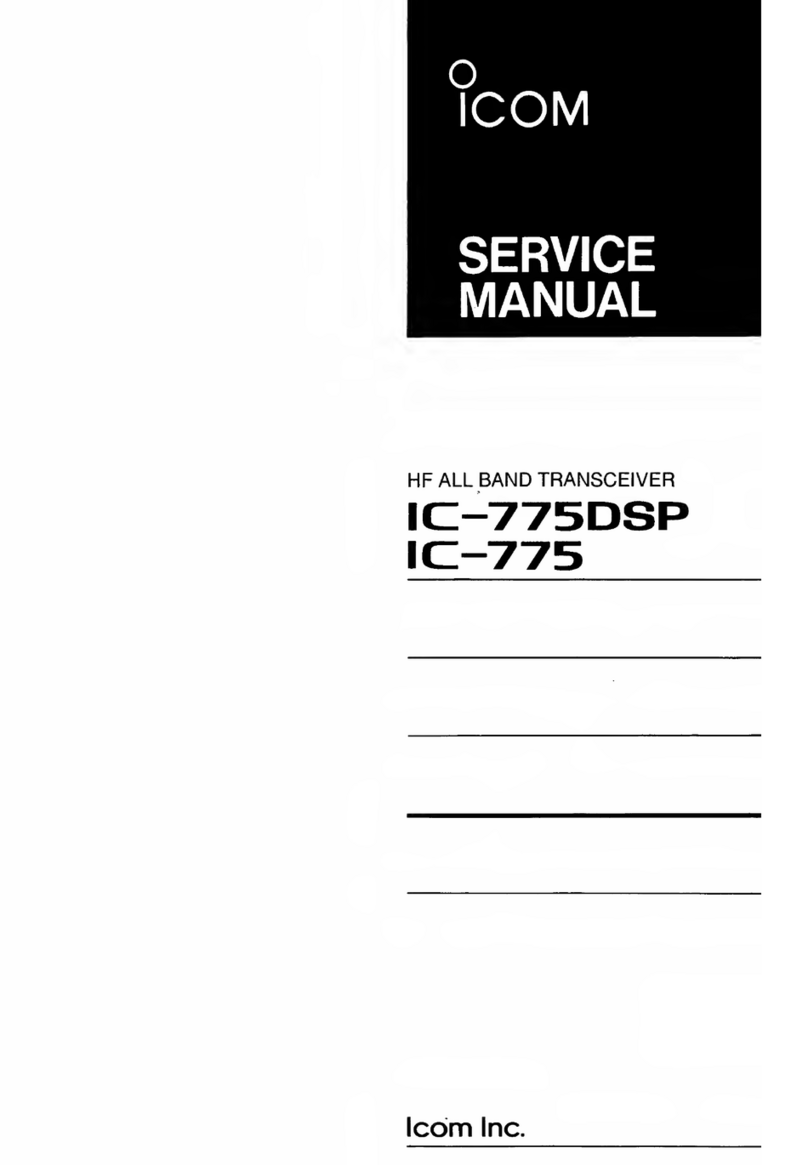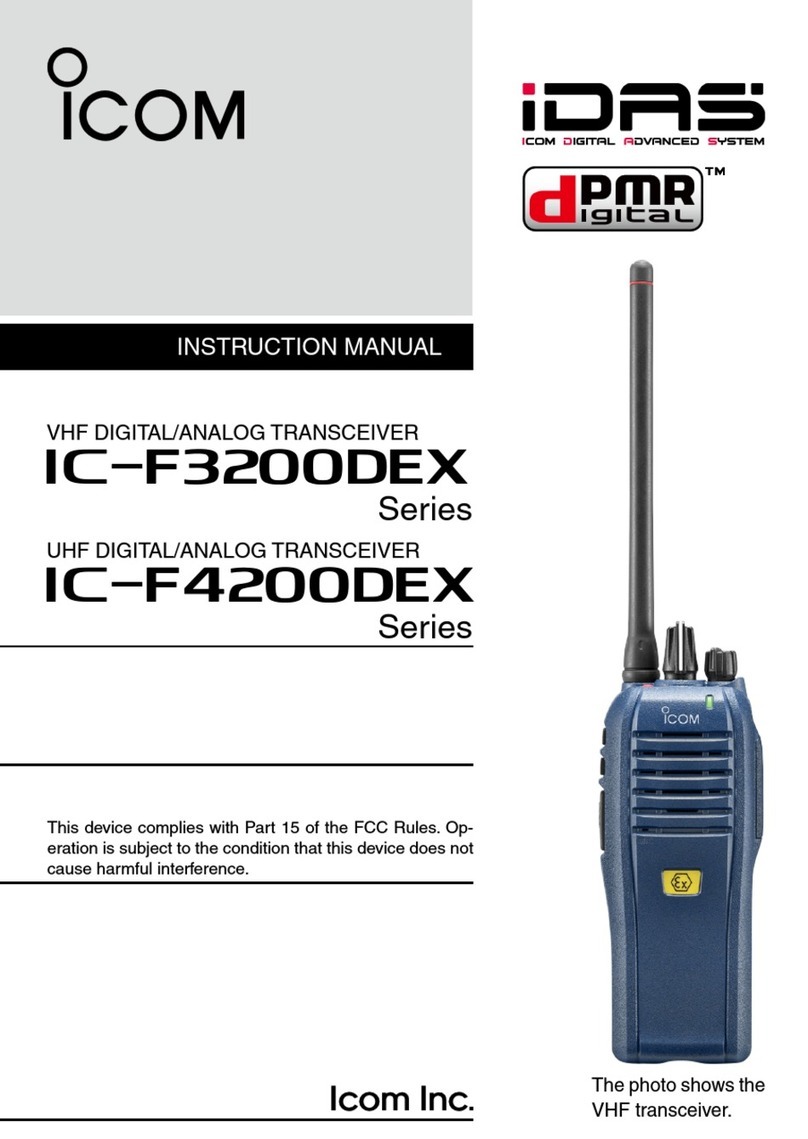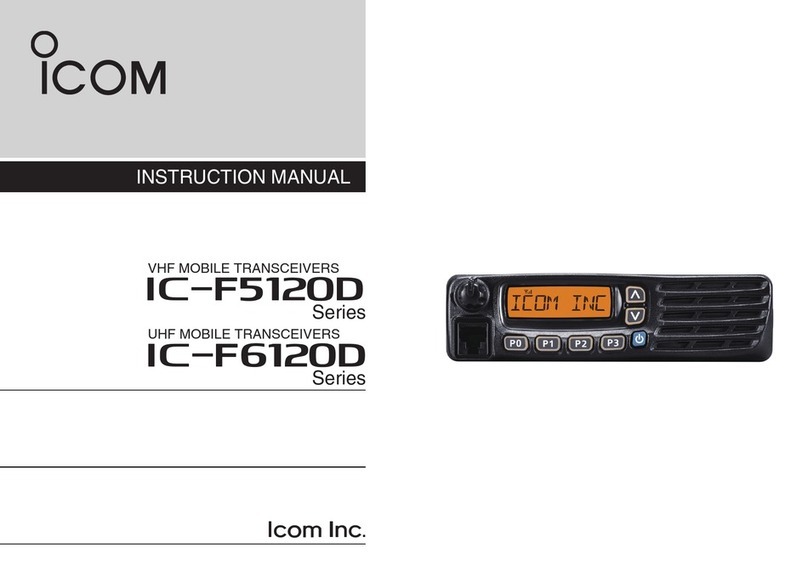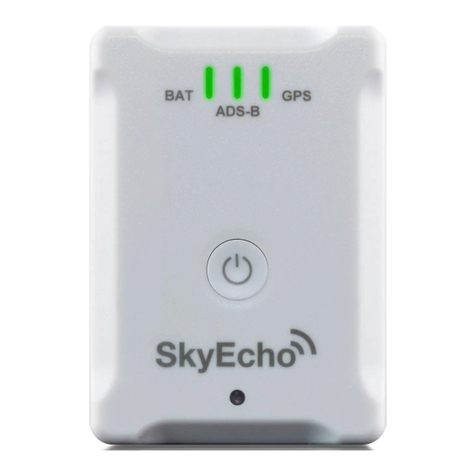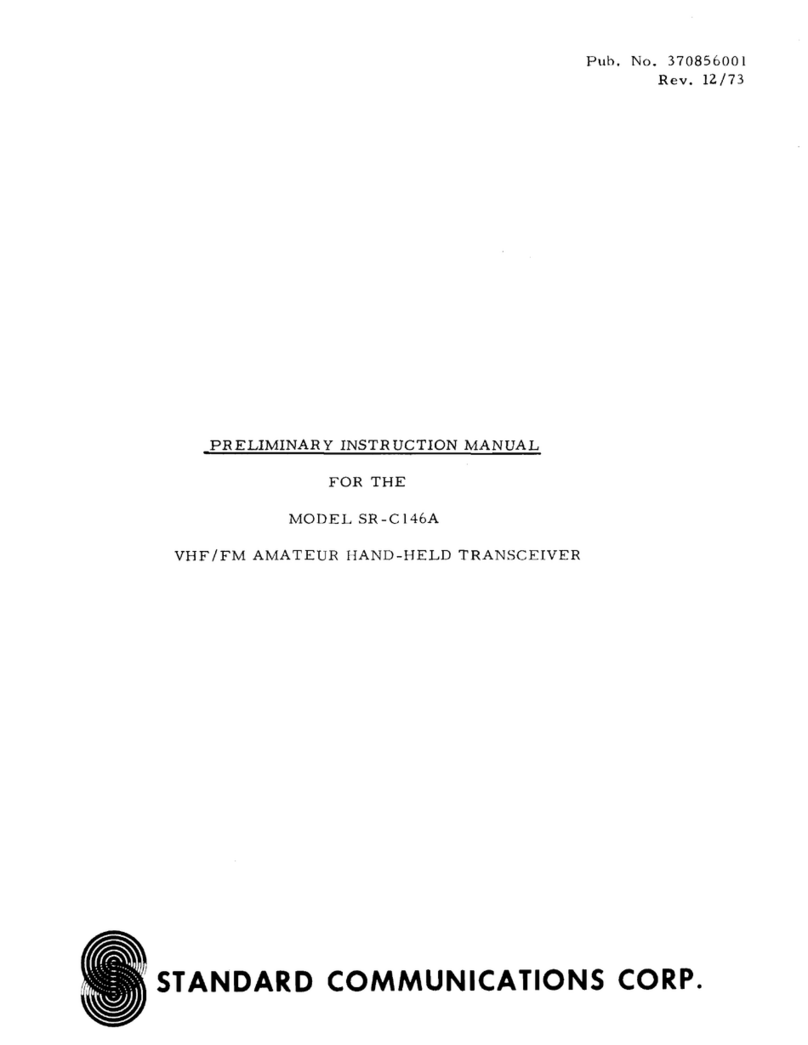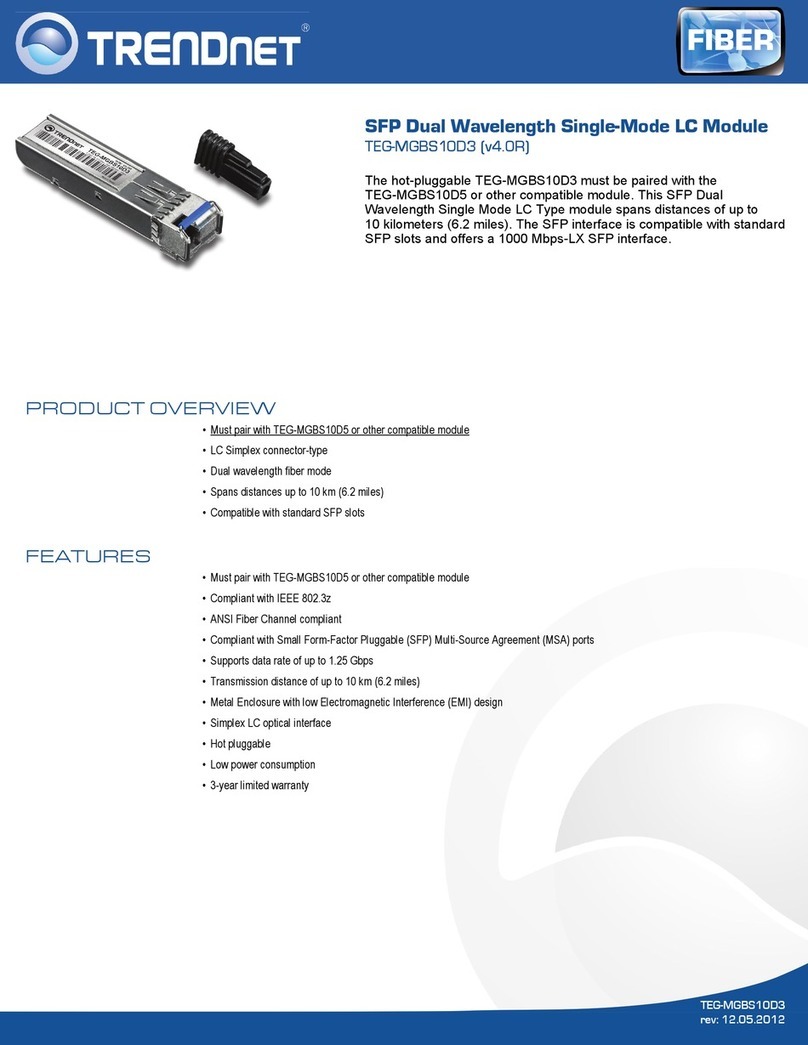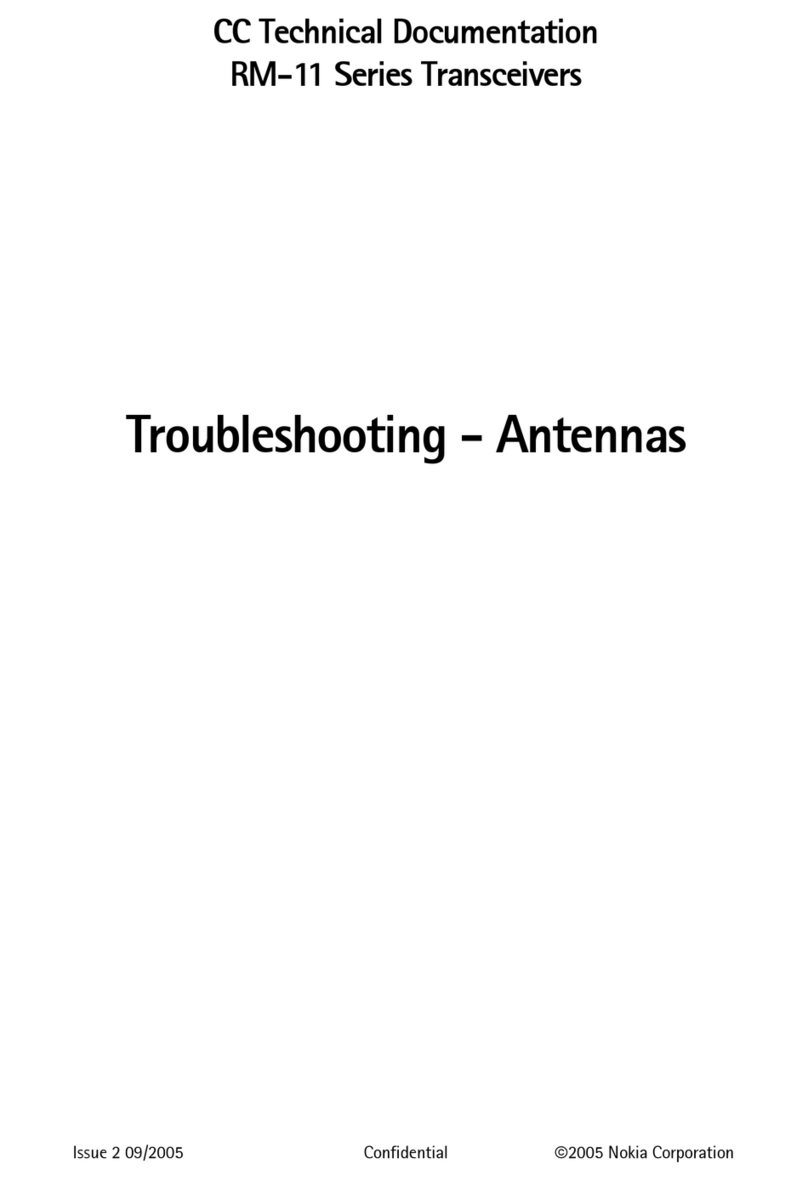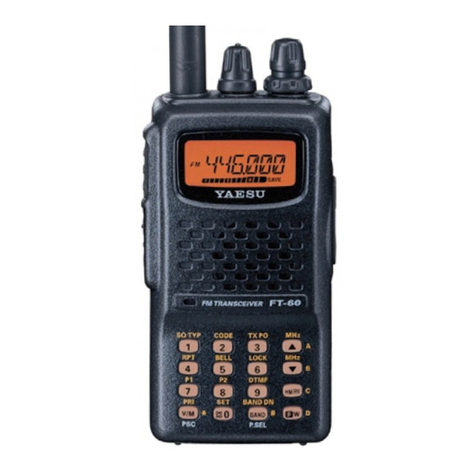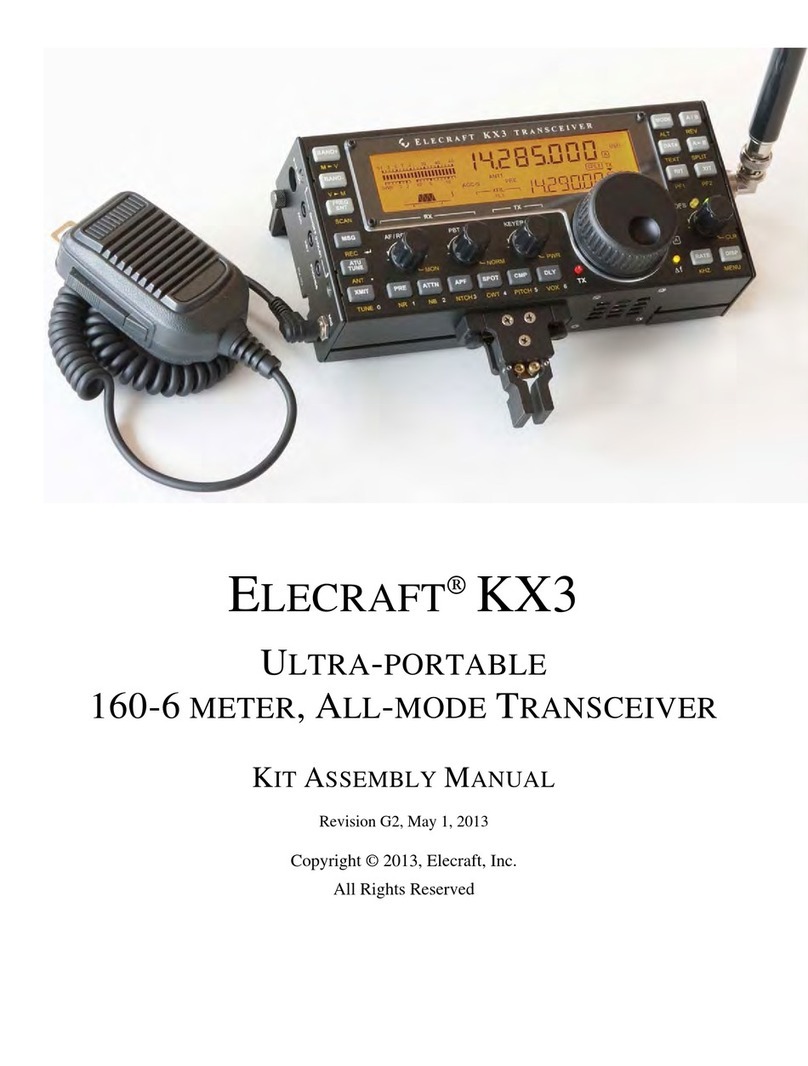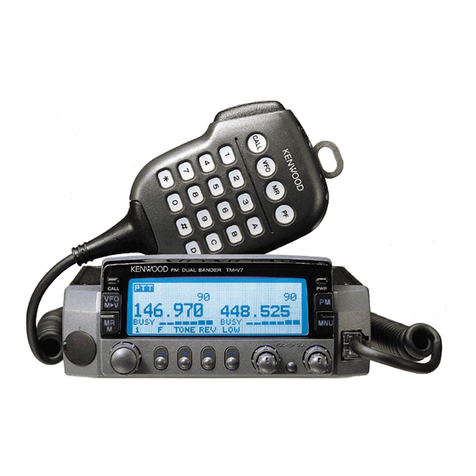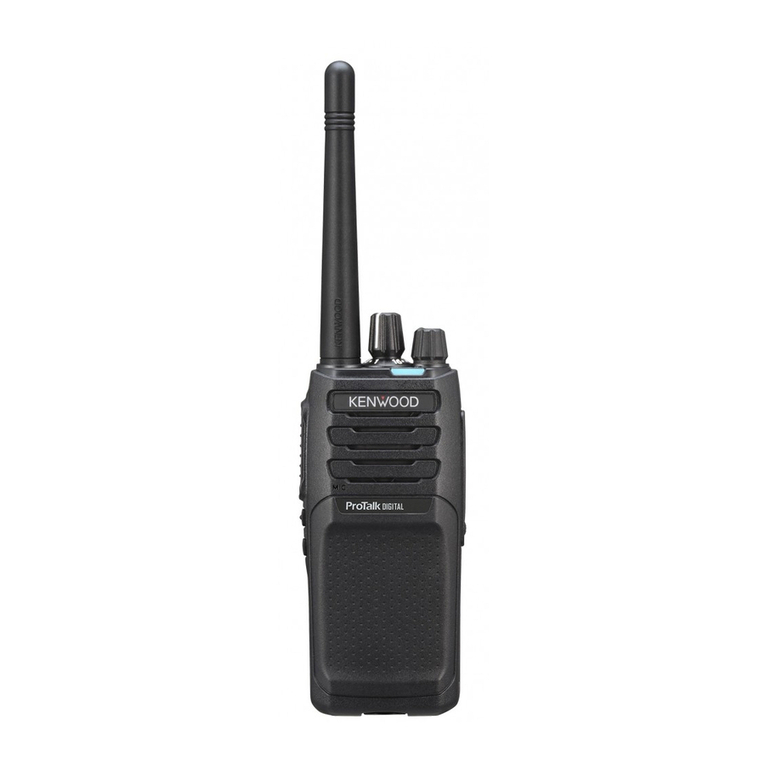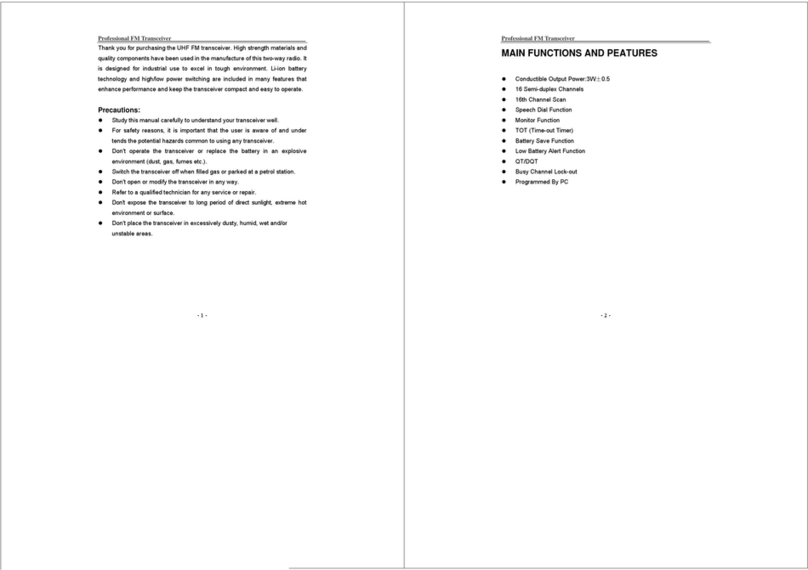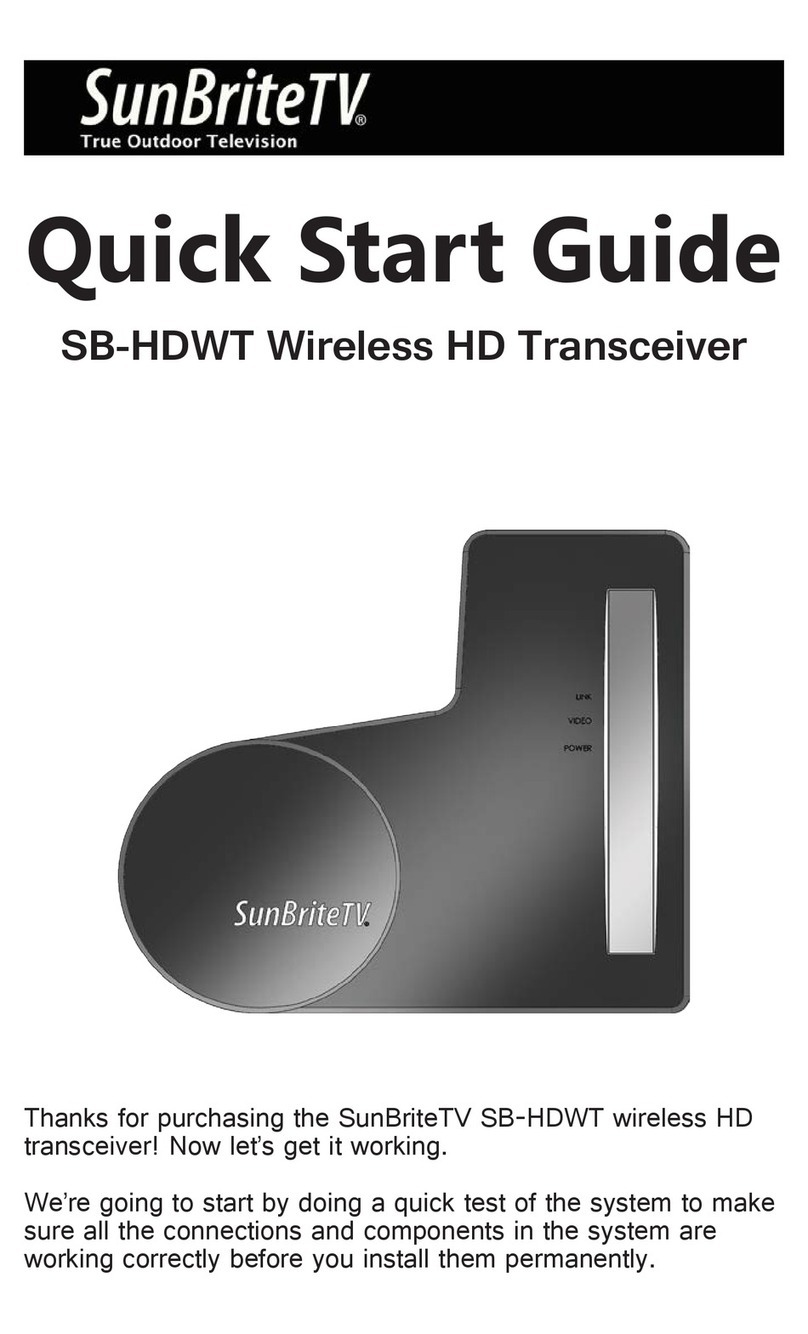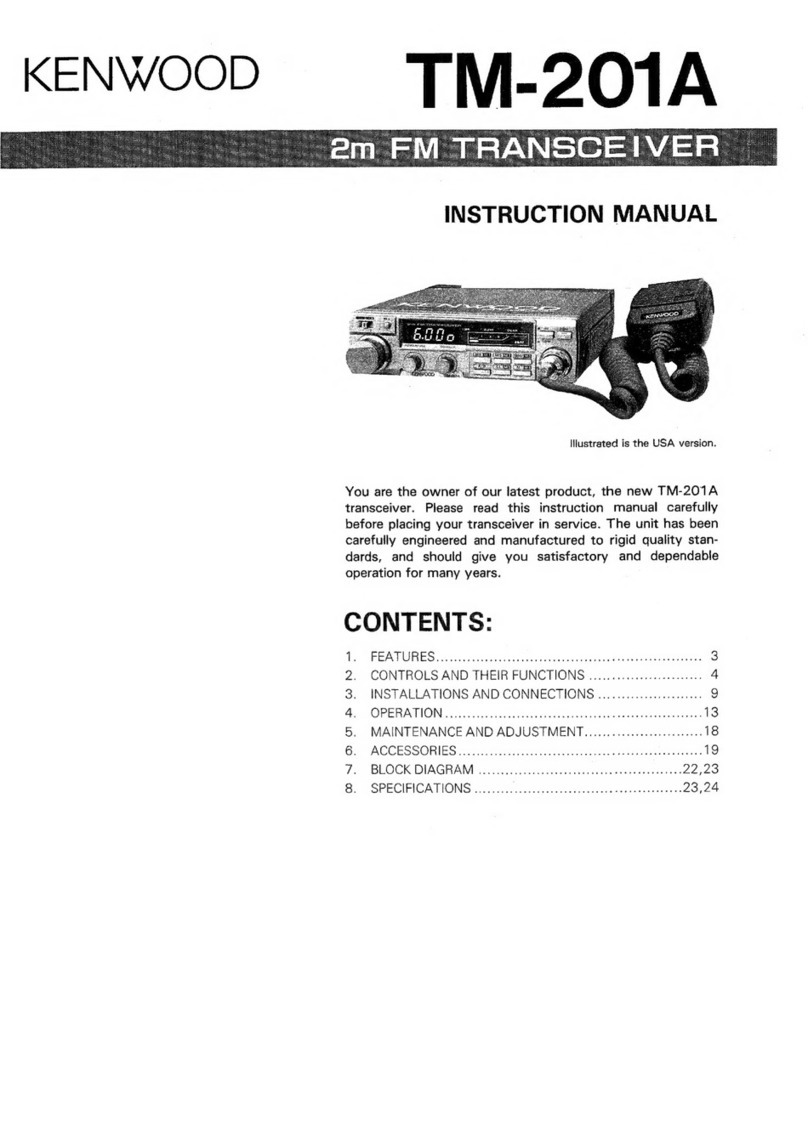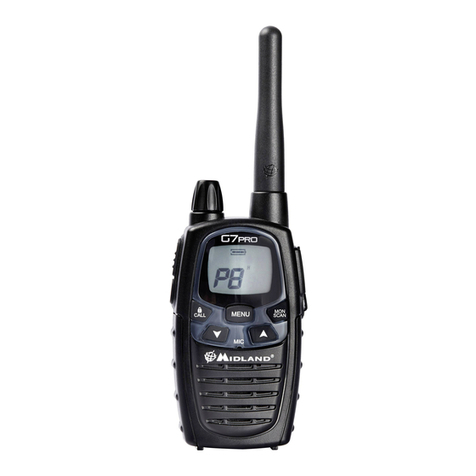Icom IC-F11BR User manual

INSTRUCTION MANUAL
UHF BRS TRANSCEIVER
iF21BR
This device complies with Part 15 of the FCC rules. Oper-
ation is subject to the following two conditions: (1) This de-
vice may not cause harmful interference, and (2) this
device must accept any interference received, including in-
terference that may cause undesired operation.
VHF BRS TRANSCEIVER
iF11BR

i
Your Icom radio generates RF electromagnetic
energy during transmit mode. This radio is de-
signed for and classified as “Occupational Use
Only”, meaning it must be used only during the
course of employment by individuals aware of the
hazards, and the ways to minimize such hazards.
This radio is NOT intended for use by the “General Popula-
tion” in an uncontrolled environment.
This radio has been tested and complies with the FCC RF expo-
sure limits for “Occupational Use Only”. In addition, your Icom radio
complies with the following Standards and Guidelines with regard to
RF energy and electromagnetic energy levels and evaluation of
such levels for exposure to humans:
• FCC OET Bulletin 65 Edition 97-01 Supplement C, Evaluating
Compliance with FCC Guidelines for Human Exposure to Radio
Frequency Electromagnetic Fields.
• American National Standards Institute (C95.1 – 1992), IEEE Stan-
dard for Safety Levels with Respect to Human Exposure to Radio
Frequency Electromagnetic Fields, 3 kHz to 300 GHz.
• American National Standards Institute (C95.3 – 1992), IEEE Rec-
ommended Practice for the Measurement of Potentially Hazardous
Electromagnetic Fields – RF and Microwave.
To ensure that your exposure to RF electromag-
netic energy is within the FCC allowable limits for
occupational use, always adhere to the following
guidelines:
•DO NOT operate the radio without a proper antenna attached, as
this may damage the radio and may also cause you to exceed FCC
RF exposure limits. A proper antenna is the antenna supplied with
WARNING
CAUTION
SAFETY TRAINING INFORMATION

ii
this radio by the manufacturer or an antenna specifically authorized
by the manufacturer for use with this radio.
•DO NOT transmit for more than 50% of total radio use time (
“
50%
duty cycle”). Transmitting more than 50% of the time can cause
FCC RF exposure compliance requirements to be exceeded. The
radio is transmitting when the “TX indicator” lights red. You can
cause the radio to transmit by pressing the “PTT” switch.
•ALWAYS use Icom authorized accessories (antennas, batteries,
belt clips, speaker/mics, etc). Use of unauthorized accessories can
cause the FCC RF exposure compliance requirements to be ex-
ceeded.
•ALWAYS keep the antenna at least 2.5 cm (1 inch) away from the
body when transmitting and only use the Icom belt-clips, listed in p. 22,
when attaching the radio to your belt, etc., to ensure FCC RF ex-
posure compliance requirements are not exceeded. To provide the
recipients of your transmission the best sound quality, hold the an-
tenna at least 5 cm (2 inches) from your mouth, and slightly off to
one side.
The information listed above provides the user with the information
needed to make him or her aware of RF exposure, and what to do to
assure that this radio operates within the FCC RF exposure limits of this
radio.
Electromagnetic Interference/Compatibility
During transmissions, your Icom radio generates RF energy that
can possibly cause interference with other devices or systems. To
avoid such interference, turn off the radio in areas where signs are
posted to do so. DO NOT operate the transmitter in areas that are
sensitive to electromagnetic radiation such as hospitals, aircraft,
and blasting sites.

iii
Your Icom IC-F21BR (UHF) operates on GMRS (Plus 7 frequen-
cies shared with FRS) and BRS frequencies. Select the fre-
quencies you desire from the Frequency Table and assign
them to channel 1 or channel 2.
GENERAL MOBILE RADIO SERVICE (GMRS);
Frequency Table Numbers 3 -17
GMRS is a two-way personal radio service available to an individual
(one man or one woman) to facilitate the activities of the individ-
ual's immediate family members. GMRS is not authorized for busi-
ness uses.
Users must cooperate in the selection and use of channels to make
the most effective use of them and reduce the possibility of inter-
ference. 7 channels are compatible with FRS channels. You can
communicate with any FRS radios on these 7 channels. FRS is a
UHF two-way voice communication service for family, friends and
associates to communicate among themselves within their neigh-
bourhood and while on group outings. Eight GMRS channels are
authorized for repeater operation*.
You must obtain a license for a GMRS system. Application is made
on FCC Form 605 or on line at http://www.fcc.gov/wtb/uls. As of
January, 2001, the license fee is $85 for a 5-year term. Schedule F
of the form permits immediate temporary operation during the
application process. Form 605 and Form 159 fee remittance advice,
are available for downloading at http://www.fcc.gov/formpage.html.
Applications may also be mailed to Federal Communications Com-
mission, Wireless Bureau Applications, PO Box 358245, Pittsburgh,
PA 15251-5245
Call 1-800-418 FORM to have the forms mailed to you, or call 1-
202-418-0177 from your fax machine to have them faxed to you on
the FCC Fax-On-Demand system. For assistance completing the
forms call 1-800-CALL-FCC.
*Repeater use may require a subscription.

iv
BUSINESS RADIO SERVICE (BRS);
Frequency Table Numbers;
IC-F21BR (UHF): 1, 2, 18-36, IC-F11BR (VHF); 1-36
BRS frequencies are a part of the FCC's Industrial/Business Pool
for the operation of a commercial activity, or the operation of edu-
cational, philanthropic, ecclesiastical institutions or clergy activities,
or the operation of hospitals, clinics, or medical associations.
The itinerant BRS frequencies in the IC-F11/F21BR are not desig-
nated for permanent use and need not be processed by a fre-
quency coordinator. No protection is provided from interference
from other itinerant operations.
You must obtain a license for a BRS system. Application for a BRS
license is made on FCC Form 601 or on line at
http://www.fcc.gov/wtb/uls/ Universal Licensing System. As of Jan-
uary, 2001, the license fee is $120 for a 10-year term. Forms 601
and 159 are available for downloading from the FCC's Internet
homepage on the World Wide Web at http://www.fcc.gov/form-
page.html.
Applications for BRS may be mailed to Federal Communications
Commission, Wireless Bureau Applications, P.O. Box 358130, Pitts-
burgh, PA 15251-5130.
Before filling out your FCC Form 601 application Technical Data
section, you must decide which frequency (or frequencies) you will
operate on. See the frequency charts on pgs. 14 and 16.
Call 1-800-418 FORM to have the forms mailed to you, or call 1-
202-418-0177 from your fax machine to have them faxed to you on
the FCC Fax-On-Demand system.

v
FOREWORD
Thank you for purchasing the IC-F11/F21BR FM transceiver.
READ ALL INSTRUCTIONS carefully and completely before using
the transceiver.
SAVE THIS INSTRUCTION MANUAL–This instruction manual
contains important operating instructions for the transceiver.
IMPORTANT
RCAUTION! NEVER hold the transceiver so that the antenna is
very close to, or touching exposed parts of the body, especially the
face or eyes, while transmitting. The transceiver will perform best if
the microphone is 2 to 4 in. (5 to 10 cm) away from the lips and the
transceiver is vertical.
RCAUTION! NEVER operate the transceiver with a headset or
other audio accessories at high volume levels.
RCAUTION! NEVER short the terminals of the battery pack.
DO NOT push the PTT when not actually desiring to transmit.
AVOID using or placing the transceiver in direct sunlight or in areas
with temperatures below –22°F (–30°C) or above +140°F (+60°C).
DO NOT modify the transceiver for any reason.
KEEP the transceiver from the heavy rain, and Never immerse it in
water. The transceiver construction is water resistant, not water-
proof.
The use of non-Icom battery packs/chargers may impair transceiver
performance and invalidate the warranty.
FCC caution: Changes or modifications to this transceiver, not
expressly approved by Icom Inc., could void your authority to op-
erate this transceiver under FCC regulations.

vi
TABLE OF CONTENTS
SAFETY TRAINING INFORMATION . . . . . . . . . . . . . . . . . . . .i-ii
ABOUT GMRS and BRS . . . . . . . . . . . . . . . . . . . . . . . . . . . .iii-iv
FOREWORD . . . . . . . . . . . . . . . . . . . . . . . . . . . . . . . . . . . . . . .v
IMPORTANT . . . . . . . . . . . . . . . . . . . . . . . . . . . . . . . . . . . . . . .v
TABLE OF CONTENTS . . . . . . . . . . . . . . . . . . . . . . . . . . . . . .vi
1 PANEL DESCRIPTION . . . . . . . . . . . . . . . . . . . . . . . . . . .1–3
‘Switches, controls, keys and connectors . . . . . . . . . . . .1–2
‘LED indicator . . . . . . . . . . . . . . . . . . . . . . . . . . . . . . . . . . .3
2 ACCESSORIES . . . . . . . . . . . . . . . . . . . . . . . . . . . . . . . . . . .4
3 BATTERY PACKS . . . . . . . . . . . . . . . . . . . . . . . . . . . . . .5–11
‘Battery pack replacement . . . . . . . . . . . . . . . . . . . . . . . . .5
‘Battery cautions . . . . . . . . . . . . . . . . . . . . . . . . . . . . . . . . .6
‘Battery charging . . . . . . . . . . . . . . . . . . . . . . . . . . . . . . .7-9
‘ Charging NOTE . . . . . . . . . . . . . . . . . . . . . . . . . . . . . . .10
‘ Battery case (Option) . . . . . . . . . . . . . . . . . . . . . . . . . . .11
44 SSEETT MMOODDEE .. .. .. .. .. .. .. .. .. .. .. .. .. .. .. .. .. .. .. .. .. .. .. .. .. .. .. .. .. .. .. .. .. .. ..12-20
‘Set mode . . . . . . . . . . . . . . . . . . . . . . . . . . . . . . . . . . . . .12
DSet the operation Frq. for IC-F11BR . . . . . . . . . . . . .13
DSet the operation Frq. for IC-F21BR . . . . . . . . . . . . .15
5 OPERATION . . . . . . . . . . . . . . . . . . . . . . . . . . . . . . . . . .21-23
‘Receiving and transmitting . . . . . . . . . . . . . . . . . . . . . . .21
‘Setting squelch level . . . . . . . . . . . . . . . . . . . . . . . . . . . .23
‘Wide/Narrow selection . . . . . . . . . . . . . . . . . . . . . . . . . . .23
6 OPTION . . . . . . . . . . . . . . . . . . . . . . . . . . . . . . . . . . . . . .24-25
Icom, Icom Inc. and the logo are registered trademarks of
Icom Incorporated (Japan) in the United states, the United King-
dom, Germany, France, Spain, Russia and/or other countries.

1
PANEL DESCRIPTION
1
‘‘Switches, controls, keys and
connectors
y
u
Speaker
Mic
w
e
r
t
q
i
SP MIC
CH1↔CH2
Mic UP
Mic A
Mic Down
Mic B
•HM-75A (OPTION)

Mic Up Same as [MONI(Audi)] key (p. 22)
Mic Down Same as [W/N] key (p. 23)
Mic A Push to select CH 1
Mic B Push to select CH 2
2
1
PANEL DESCRIPTION
qCHANNEL SELECTOR/SW [CH]
Toggle the CH switch to select CH1 or CH2.
wVOLUME CONTROL [OFF/VOL]
Turns power ON and adjusts the audio level.
eMONITOR (Audi) key [MONI] (p. 22)
•Push and hold to open the noise/tone squelch.
•Push to turn the noise/tone squelch ON.
rPTT SWITCH [PTT]
Push and hold to transmit; release to receive.
tWIDE/NARROW KEY [W/N] (p. 23)
•Push to select Wide deviation.
•Push and hold to select Narrow deviation.
yANTENNA CONNECTOR
Connects the supplied antenna.
uTX/RX INDICATOR LED (p. 3)
•Lights red while transmitting.
•Lights green while receiving a signal, or squelch is open.
i[SP]/[MIC] JACK
Connects optional speaker-microphone.
DDHM-75A key reference (OPTION)*
*These functions are available when the optional Speaker/Mic. is con-
nected.
1

‘‘LED indicator
The TX/RX indicator LED indicates informa-
tions several ways as follows;
(Ref.; R=Red, G=Green)
PANEL DESCRIPTION
1
3
R R R R
R R
R R R R
R R
G
R
•TX: Turns Red while transmitting a signal.
•RX: Turns Green while receiving a signal.
•Low BATT1: You should charge the battery. (blinks slowly)
•Low BATT2: You must charge the battery. (blinks fast)
•TX low BATT1: Low BATT1 was detected during TX mode.
•TX low BATT2: Low BATT2 was detected during TX mode.
CAUTION:
•Low BATT3: If you did not charge the battery after Low BATT2
warning has appeared, the Low BATT3 warning beep emits for 15
sec. then the power turns OFF automatically.

2
ACCESSORIES
4
‘‘Accessory attachment
DSupplied accessories
The transceiver comes supplied with the following accessories.
qFlexible antenna
wBelt clip
DAntenna
The antenna screws onto the transceiver as
illustrated at right.
DBelt clip
Attach the belt clip to the transceiver as illustrated below.
q
w
2

5
3BATTERY PACKS
‘‘Battery pack replacement
Before replacing the battery pack, the volume control MUST be ro-
tated fully counterclockwise,
until a click is heard, to turn the
power OFF.
•Push the battery release for-
ward, then pull the battery
pack upward with the trans-
ceiver facing you.
DDBATTERY PACKS
*1Operating periods are calculated under the following conditions;
Tx : Rx : standby =5 : 5 : 90
*1Operating period depends on the alkaline cells used. (BP-208 only)
*2Output power is automatically reduced to 1 W to retain sufficient power
in case of an emergency, etc.
*3Operating period measured with the 2 W model.
yrettaB
kcap egatloV yticapaC
doirepgnigrahC
gnitarepO
*doirep
1
BC-146
BP-208*
2
AArofesacyretta
B
)6R( ×enilakla6
902-PB V2.7srh21srh5.1srh8
012-PB V2.7 0561
hAm 18.5 hrs srh0.2srh11
1100
mAh
BP-222*
3
V2.7 006
hAm rh1 hrs
5.5*
3
6.5 hrs
BC-144,
BC-119 or
BC-121

6
3
BATTERY PACKS
‘‘Battery cautions
•CAUTION! NEVER short the terminals of the battery pack (or
charging terminals of the transceiver). Also, current may flow into
nearby metal objects such as a necklace, so be careful when plac-
ing battery packs (or the transceiver) in handbags, etc.
Simply carrying with or placing near metal objects such as a neck-
lace, etc. causes shorting. This will damage not only the battery
pack, but also the transceiver.
•NEVER incinerate used battery packs. Internal battery gas may
cause an explosion.
•NEVER immerse the battery pack in water. If the battery pack be-
comes wet, be sure to wipe it dry BEFORE attaching it to the
transceiver.
•Clean the battery terminals to avoid rust or miss contact.
•Keep battery contacts clean. It’s a good idea to clean battery ter-
minals once a week.
If your battery pack seems to have no capacity even after being
charged, completely discharge them, then fully charge the battery
pack again. If the battery pack still does not retain a charge (or only
very little charge), a new battery pack must be purchased.
DDRecycling information (U.S.A. only)
The battery (BP-209, BP-210 or BP-222) that you
have purchased is recyclable. At the end of its life,
under various state and local laws, it may be illegal
to dispose of this battery into the municipal waste
stream. Call 1-800-822-8837 for battery recycling
options in your area or contact your dealer.
3

7
3BATTERY PACKS
‘‘Battery charging
DRapid charging with the BC-144+AD-99
The optional BC-144 provides rapid charging of optional battery
packs.
The following are additionally required:
•One AD-99 (depends on version.).
•An AC adaptor (may be supplied with the BC-144 depending on
version).
AC adaptor
BC-145A/E/V/UK
BP-209, BP-210
or BP-222 only
Charging indicator
Check orientation.

8
3
BATTERY PACKS
DRapid charging with the BC-144+AD-99
DDSpacer combination.
•Be sure to attach the
spacer (Spacer B/C) to
the adapter (Spacer A)
with the orientation as il-
lustrated in the diagram at
right.
•Attach the spacer
(Spacer B/C) to the adap-
tor with the orientation of the stamp “”pointing up.
NOTE: Push the notch carefully
when removing the spacer from the
adaptor.
Turn power OFF
BP-209, BP-210
or BP-222 attached
to the transceiver.
AC adaptor
BC-145A/E/V/UK
Charging indicator
Check orientation
and
Spacer A
Spacer B/C
Check orientation
and the spacer com-
bination as follows.
3

9
3BATTERY PACKS
DRapid charging with the BC-121+AD-94 (#11)
The optional BC-121 allows up to 6 battery packs to be charged si-
multaneously. The following are additionally required.
•Six AD-94 (#11) (Some versions require additional AD-99s).
•An AC adaptor (may be supplied with the BC-121 depending on
version).
DRegular charging with the BC-146
The optional BC-146 pro-
vides regular charging of
optional battery pack with/
without transceiver.
The following is additionally
required:
•An optional AC adapter.
(A charging spacer is sup-
plied with BC-146.)
MULTI-CHARGER
AC adaptor
(purchased
separately)
Charge indicator
(each indicator functions independently)
Turn power OFF.
AD-99
Check orientation
for correct charg-
ing.
(Insert togeth-
er with charging
adapter.)
Turn power OFF.
BC-146

10
3
BATTERY PACKS
‘‘Charging NOTE
Prior to using the transceiver for the first time, the battery pack must
be fully charged for optimum life and operation.
•Recommended temperature range for charging:
+10°C to +40°C (50°F to 140°F).
•Use the supplied charger or optional charger (BC-119/BC-121/BC-
144 for rapid charging, BC-146 for regular charging) only. NEVER
use other manufacturers’chargers.
The optional BP-209, BP-210 or BP-222 battery packs include
rechargeable Ni-Cd(Ni-MH: BP-210) batteries and can be charged
approx. 300 times. Charge the battery pack before first operating
the transceiver or when the battery pack becomes exhausted.
If you want to charge the battery pack more than 300 times, the fol-
lowing points should be observed:
•Avoid overcharging–batteries must be removed from the charger
to stop charging. Batteries should not be charged for more than
20 hours after the LED indicator turns green.
•Use the battery until it becomes almost completely exhausted
under normal conditions.
DDBattery pack life
When the operating period becomes extremely short even after
charging the battery pack fully, a new battery pack is needed.
NOTE: The charger rapidly charges a battery pack to a speci-
fied level, not a completed level, to prevent overcharging. Leave
the battery pack in the charger for a few more hours (up to
15 hours; depending on battery condition) after the LED indica-
tor turns green, to charge the battery completely.
3

‘‘Battery case (Option)
When using a BP-208 OPTIONAL BATTERY CASE attached to the
transceiver, install 6 AA (R6) size alkaline batteries as illustrated
below.
NOTE: Output power is automatically reduced to 1 W to retain suffi-
cient power in case of an emergency, etc.
DDCAUTIONS
•Use ALKALINE batteries only.
•Make sure all battery cells are the same brand, type and ca-
pacity.
•Never mix old and new batteries.
Either of the above may cause a fire hazard or damage the
transceiver, if ignored.
•Never incinerate used battery cells since internal battery gas
may cause them to rupture.
•Never expose a detached battery case to water.
If the battery case gets wet, be sure to wipe it dry before using
it.
11
3BATTERY PACKS

12
4
SET MODE
‘‘Set mode
Set mode is used for programming infrequently changed values or
conditions of functions.
•All settings performed with [CH 1/CH 2], [OFF/VOL], [MONI],
[PTT] and [W/N] keys.
DDSETTING THE OPERATION
FREQUENCY
The operating frequency can be
selected from GMRS* ( Plus 7
frequencies shared with FRS*)
and BRS frequencies. (pgs.
13–14 for IC-F11BR, pgs. 15–16
for IC-F21BR)
* IC-F21BR (UHF model) only.
DDSETTING THE CTCSS TONE
FREQUENCY
CTCSS (Continuous Tone Coded Squelch System) encoder/decoder
are standard, providing quiet stand-by. (pgs. 17–18)
DDFREQUENCY FIND
This transceiver can detect the operating frequency by scanning
the all pre-programmed channels. (p. 19)
DDCTCSS FIND
This transceiver can detect the CTCSS tone frequency in the re-
ceived signal. (p. 20)
[MONI]
[PTT]
[W/N]
[OFF/VOL]
[CH 1/CH 2]
4

13
4SET MODE
DDIC-F11BR (VHF) SETTING THE OPERATION FREQUENCY
The operating frequency can be selected from 36 frequencies. (See
right.) Select the frequencies you desire from the frequency table
and assign them to CH 1 and CH 2.
•Default settings are as follows;
CH 1: Operating CH No. 1 (154.5700 MHz), CTCSS: No. 0 (OFF)
CH 2: Operating CH No. 2 (154.6000 MHz), CTCSS: No. 0 (OFF)
qWhile pushing and holding [PTT], [MONI] and [W/N], turn
[OFF/VOL] to power ON.
wSelect the desired CH 1 or CH 2 that you want to assign the fre-
quency to.
ePush and hold [W/N] until a beep (Pi) is emitted.
rPush [PTT] the necessary number of times to choose the 10 digit
of the desired channel from the channel list.
tPush [MONI].
yPush [PTT] the necessary number of times to choose the 1 digit
of the desired channel from the frequency list.
uPush [MONI].
iTurn the power OFF, and then ON again.
[Example]
To assign Frequency channel No. 28 as CH1;
qWhile pushing and holding [PTT], [MONI] and [W/N], turn
[OFF/VOL] to power ON.
wSelect the CH 1.
ePush and hold [W/N] until a beep (Pi) is emitted.
rPush [PTT] twice to choose the 10 digit of the desired channel.
tPush [MONI].
yPush [PTT] eight times to choose the 1 digit of the desired chan-
nel.
uPush [MONI].
iTurn the power OFF, and then ON again.
This manual suits for next models
1
Table of contents
Other Icom Transceiver manuals
